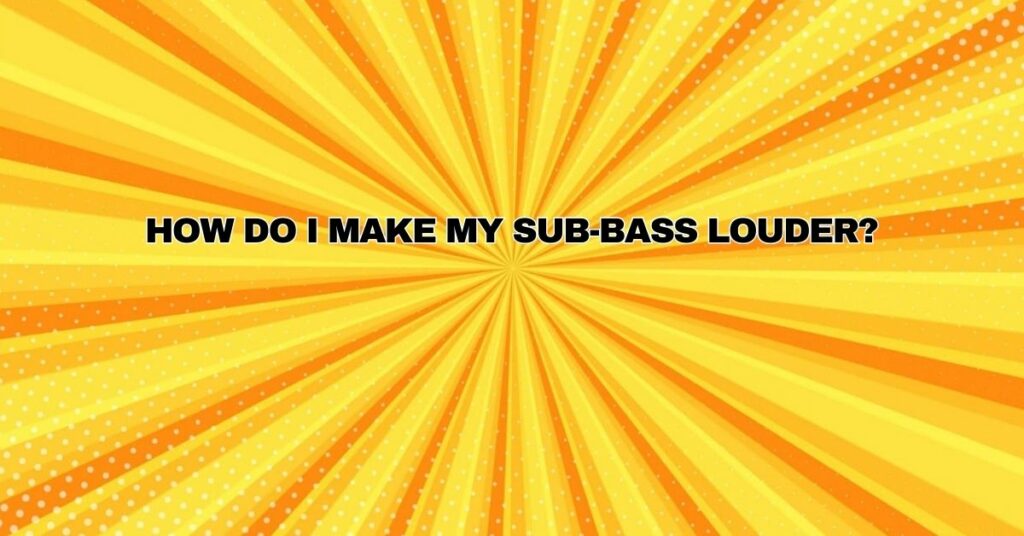Sub-bass frequencies are the heart and soul of many music genres, adding depth and power to your tracks. Whether you’re a music producer, DJ, or an avid music enthusiast, knowing how to make your sub-bass louder and more impactful is essential for creating tracks that thump with energy and groove. In this comprehensive article, we’ll delve into various techniques, tips, and production strategies to help you achieve that coveted, chest-thumping sub-bass.
- Choosing the Right Sound Source
The foundation of powerful sub-bass is a high-quality sound source. Start with a sub-bass sound that has a strong, clean character. You can create or select sub-bass patches in synthesizers, use dedicated sub-bass samples, or even record live instruments for an organic touch.
- Subtractive EQ to Clean Up the Mix
Before turning up the volume, it’s essential to ensure that your sub-bass sound isn’t clashing with other elements in the mix. Use subtractive EQ techniques to clean up the low end:
- High-Pass Filter: Apply a high-pass filter to other tracks to remove unnecessary low frequencies, making room for the sub-bass.
- Frequency Sweeping: Use an EQ to identify and reduce any resonant or unwanted frequencies in your sub-bass.
- Layering for Richness
Layering is a powerful technique to create a full and impactful sub-bass. Blend multiple sub-bass sounds, each with distinct characteristics:
- Pure Sub: Start with a clean, sine wave sub-bass sound as your foundation. This sound offers a pure, deep bass tone.
- Harmonic Layers: Layer the sub with additional sounds that have harmonics, like a square or sawtooth wave. These layers add richness and character to the sub-bass.
- Distorted Layer: For added grit and edge, consider layering in a distorted sub-bass sound. This can provide a more aggressive and in-your-face quality.
- Balancing the Sub-Bass and Kick Drum
The relationship between the sub-bass and kick drum is crucial for a punchy and impactful low end. Here’s how to balance them effectively:
- Sidechain Compression: Apply sidechain compression to the sub-bass, triggered by the kick drum. This technique temporarily reduces the sub-bass’s volume every time the kick drum hits, allowing them to coexist without clashing.
- EQ and Tuning: Use EQ to carve out space for the kick drum and sub-bass. Ensure the fundamental frequency of your sub-bass doesn’t overlap with the kick drum’s frequency.
- Volume and Saturation
Increasing the volume of your sub-bass is one of the most direct ways to make it louder. However, it’s crucial to maintain clarity and prevent distortion. Consider these techniques:
- Volume Automation: Gradually increase the sub-bass volume over time, particularly in the build-up to drops or climactic moments in your track.
- Saturation and Distortion: Gently saturate or add distortion to the sub-bass. This can introduce harmonics and make the sub-bass sound louder without necessarily increasing its actual volume.
- Sub-Bass Stereo Imaging
While sub-bass is typically monophonic and centered, adding subtle stereo width to harmonically rich sub-bass layers can enhance its perceived loudness and presence. Use stereo imaging tools or chorus effects for this purpose.
- Mono Compatibility
Since sub-bass is meant to be felt as much as heard, it’s crucial to ensure that it remains mono-compatible. Check your mix in mono to confirm that the sub-bass still carries its weight in the center channel without phase cancellation issues.
- Frequency Modulation (FM) Synthesis
FM synthesis is a powerful method to create complex and evolving sub-bass sounds. Experiment with FM synthesis techniques to generate unique sub-bass timbres that stand out in the mix.
- Sub-Bass Layer Effects
Enhance the sub-bass layers with effects that give them character and movement:
- Filter Modulation: Apply filter modulation to introduce subtle filter sweeps or movement in your sub-bass layers.
- Pitch Modulation: Automate pitch modulation to create pitch slides or bends for added impact.
- Resonance and Envelopes: Use resonance and envelope settings to shape the attack and decay of your sub-bass layers.
- Room Acoustics and Sub-Bass
Sub-bass can interact differently with room acoustics, which can affect its perceived loudness. Pay attention to your room setup, as the acoustics can reinforce or diminish the sub-bass in your production space.
- Subwoofer and Monitoring Setup
If you’re creating music for live performance, having a high-quality subwoofer and appropriate monitoring setup can be essential. Make sure your subwoofer is capable of reproducing sub-bass frequencies accurately.
- Professional Mixing and Mastering
For the final polish and to ensure your sub-bass translates well on various playback systems, consider professional mixing and mastering services. Experienced engineers can make precise adjustments to enhance the sub-bass impact.
- Continuous Learning and Experimentation
The world of music production and sub-bass enhancement is continually evolving. Keep learning, experimenting, and staying updated with the latest techniques and tools to push the boundaries of your sub-bass.
Conclusion
Making your sub-bass louder and more impactful involves a combination of sound selection, layering, EQ, volume control, and various production techniques. By carefully balancing the elements in your mix, focusing on clarity, and experimenting with different approaches, you can achieve sub-bass that not only sounds loud but also provides a visceral and memorable experience. Whether you’re producing EDM, hip-hop, or any genre that relies on powerful sub-bass, these techniques will help you take your music to the next level, making your tracks throb with energy and groove.


